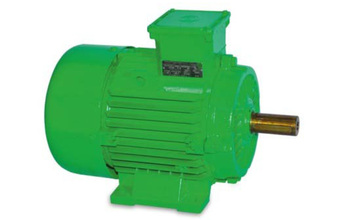
Bharat Bijlee's SynchroVERT motor
Almost all new plastic injection moulding and extrusion plants now specify IE2 or IE3 motors. Existing plants can also greatly benefit from the replacement of existing old motors with new IE3 or even IE4 superior efficiency class motors.
The Indian government has mandated that - with effect from October 2017 - all induction motors manufactured and sold in India must have minimum IE2 (High efficiency) efficiency levels. This will ensure that no low efficiency motor is sold in India. However, for those industries where motors run for significant amount of time selection of efficiencies even higher than IE2, viz IE3 (Premium efficiency) or IE4 (Super Premium efficiency) motors can make strong economic sense.
With power tariff rate increasing over 5% CAGR and considering motor life of 15 years, IE4 range motors have a payback period of less than a year and the life time saving for a typical 15 kW motor is Rs. 11.7 lakh with incremental investment of Rs. 0.5 lakh.
Performance parameters of higher efficiency class motors
Operating speed and slip
In general, motors with higher efficiency have a higher operating speed i.e. a reduced slip compared to motors of lower efficiency. Usually the slip is reduced by some 20 to 30% per next higher efficiency class for motors of the same rated output power.
Problems observed when used for variable torque applications like fans and pumps
Several customers have faced the problem of input power increasing when the customer has replaced existing standard motors with IE2/IE3/IE4 motors. The reason for the increase in power consumption is explained below.
As a general rule, high-efficiency cage-induction motors, have a higher speed of rotation than motors of lower efficiency. When the torque of the application is a function of the square of the speed (centrifugal loads), like in pumps, fans, etc., the increase in speed will lead to an increase in output power (torque) which could in some circumstances defeat the benefits from the improved energy efficiency.
Even a minor change in the motor's full-load speed translates into a significant change in the magnitude of the load and energy consumption. The "fan" or "parabolic law," shows that the kilowatt loading on a motor varies as the third power (cube) of its rotational speed. In contrast, the quantity of air/water delivered varies linearly with speed.
|
|
eff |
speed |
Torque |
Power output |
Power input |
|
|
% |
rpm |
Nm |
kW |
kW |
|
IE1 |
87.6 |
1464 |
75.4 |
11,559 |
13,195 |
|
IE2 |
89.8 |
1474 |
76.4 |
11,792 |
13,131 |
|
IE3 |
91.4 |
1480 |
77.1 |
11,948 |
13,073 |
|
|
92.6 |
1500 |
79.2 |
12.433 |
13,426 |
(Continued on next page)




































